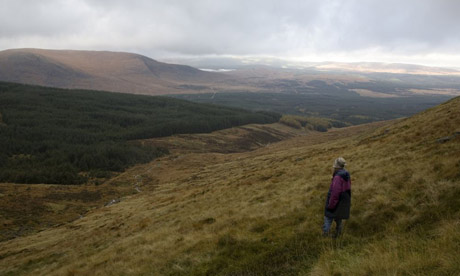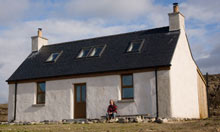Sara Maitland skillfully weaves a history of silence and solitude over the centuries with an autobiographical
account of her own encounters with silence at her Weardale home, on the Scottish isle of Skye, in the Egyptian desert of St. Anthony, and in the isolated moors of southwestern Scotland where she finally settles. The work is honest, intense, and humane. Maitland's grasp of the subject and its literature, and her own observations of herself and her environs in silence and solitude are fresh and compelling. Maitland writes clearly and engagingly. Plus bibliographical notes and an index make rereading and further exploration easy. A Book of Silence is bound to be a hallmark on the subject.

The book opens with a summary of Maitland's own London and Oxford
University upbringing, her mix of intellect, feminism, literary creativity, and religious sentiment. She sets the tone of the book as an adventure on which the reader will want to accompany the author:
In the summer of 2000 I moved north to County Durham, to a house on a moor high about Weardale. I was eager and greedy. I wanted both to be silent and to think about silence. I set out to hunt silence and I have been doing so ever since.
Weardale (in Northumbria, England) becomes Maitland's base camp for the subsequent explorations. Chapter 2, "Forty Days and Forty Nights," describes her stay on the Scottish isle of Skye. Amidst the natural grandeur and silence, Maitland records life in fascinating detail, highlighted by reflections on voice-hearing in natural sounds, changing bodily sensations, and chronicles of solitary mountaineers and sailors. Maitland pays careful attention to the phenomena of silence itself, and how solitude elicits "an extraordinary rhythmical sequence of emotions."
Chapter 3 is "The Dark Side," that is, the psychological side of silence, the reality of surviving in a harsh environment, and accidie, the spiritual lethargy that attacks hermits. Chapter 4, "Silence and the Gods," discusses creation myths from Genesis to the Big Bang. Where non-Western stories see creation evolve from silence, Western myths insist on a loud noise that shatters the nothingness. The initial bang has evolved to noise pollution in the modern world. Western insistence on logos as word pits silence, dreams, and mystery against language, psychology, and meaning.
In Chapter 5, "Silent Places," Maitland notes how exploring silence heightens attention to nature and detail: clouds, birds, stars, wind. She learns to distinguish birds along shorelines and near islands, appreciating the feat of intrepid Celtic monks of antiquity who set out on dangerous seas in tiny boats. Maitland contrasts the evocation of the sea with forests, always historical sources of primordial fear, of Freud's heimlich unheimlich, the uncanny. From here Maitland ranges to fairy tales, linguistics, and the politics of silence.
Chapter 6 is "Desert Hermits," recording Maitland's journey to Sinai for a desert retreat. She writes chiefly of the desert hermits and their spirituality. Chapter 7 is "The Bliss of Solitude." In the desert, Maitland had sought the silence of self-effacement. In chapter 7, she pursues solitude as formative to expression, for she wonders where her creative skill (writing) will next take her given her desire for silence. Inspired by the English Romantics, Maitland pursues walking and climbing in Galloway (southwestern Scotland).
Maitland's forte is her discussion of the Romantic movement. She owns that "on my Galloway walks I took not The Sayings of the Desert Fathers but Wordsworth's Prelude." She notes how older eremitic views of silence emphasize emptying, while the Romantics used silence and nature to strengthen the ego against society. The sad history of the Highlands enclosures, however, shows how fragile is culture's hold on silence and well-being. Maitland is left unresolved, wanting to be both a "silence dweller" and a "silence writer."
In the final chapter, "Coming Home," the author buys an old shepherd's cottage in Galloway. She settles on an 80/20 silence, plugging into phone and internet 20% of the time, doing away with appliances that make noise, praying and meditating 3 hours daily, descending into a composite silence based on experiences related in the book. The fiction writer in Maitland wants to find new expression, while enjoying all of wild nature and the silence. "I am finding it hard to finish this book, because I don't feel that I am at the end of anything," Maitland concludes.
Nor will the reader want to finish the book, either, without hope of a sequel some years hence.
reviewed 2010 ¶
(http://www.hermitary.com/bookreviews/solitude-women.html)






No hay comentarios:
Publicar un comentario